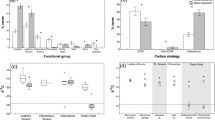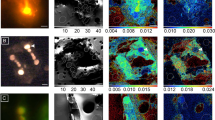Abstract
Diatoms are a key taxon of eukaryotic phytoplankton and a major contributor to global carbon fixation1. They are ubiquitous in the marine ecosystem despite marked gradients in environmental properties, such as dissolved iron concentrations, between coastal and oceanic waters. Previous studies have shown that offshore species of diatoms and other eukaryotic algae have evolved lower iron requirements to subsist in iron-poor oceanic waters, but the biochemical mechanisms responsible for their decreased iron demand are unknown2,3. Here we show, using laboratory-cultured model species, a fundamental difference between a coastal and an oceanic diatom in their photosynthetic architecture. Specifically, the oceanic diatom had up to fivefold lower photosystem I and up to sevenfold lower cytochrome b6f complex concentrations than a coastal diatom. These changes to the photosynthetic apparatus markedly decrease the cellular iron requirements of the oceanic diatom but not its photosynthetic rates. However, oceanic diatoms might have also sacrificed their ability to acclimate to rapid fluctuations in light intensity—a characteristic of dynamic and turbid coastal waters. We suggest that diatoms, and probably other eukaryotic algal taxa, exploited this difference in the underwater light climate between oceanic and coastal waters, enabling them to decrease their iron requirements without compromising photosynthetic capacity. This adaptation probably facilitated the colonization of the open ocean by diatoms, and contributes to their persistence in this iron-impoverished environment.
This is a preview of subscription content, access via your institution
Access options
Subscribe to this journal
Receive 51 print issues and online access
$199.00 per year
only $3.90 per issue
Buy this article
- Purchase on Springer Link
- Instant access to full article PDF
Prices may be subject to local taxes which are calculated during checkout



Similar content being viewed by others
References
Dugdale, R. C. & Wilkerson, F. P. Silicate regulation of new production in the equatorial Pacific upwelling. Nature 391, 270–273 (1998)
Sunda, W. G., Swift, D. G. & Huntsman, S. A. Low iron requirement for growth in oceanic phytoplankton. Nature 351, 55–57 (1991)
Sunda, W. G. & Huntsman, S. A. Iron uptake and growth limitation in oceanic and coastal phytoplankton. Mar. Chem. 50, 189–206 (1995)
Ryther, J. H. & Kramer, D. D. Relative iron requirements of some coastal and offshore plankton algae. Ecology 42, 444–446 (1961)
Brand, L. E., Sunda, W. G. & Guillard, R. R. L. Limitation of marine phytoplankton reproductive rates by zinc, manganese, and iron. Limnol. Oceanogr. 28, 1182–1198 (1983)
Maldonado, M. T. & Price, N. M. Influence of N substrate on Fe requirements of marine centric diatoms. Mar. Ecol. Prog. Ser. 141, 161–172 (1996)
Raven, J. A. Predictions of Mn and Fe use efficiencies of phototrophic growth as a function of light availability for growth and of C assimilation pathway. New Phytol. 116, 1–18 (1990)
Raven, J. A., Evans, M. C. W. & Korb, R. E. The role of trace metals in photosynthetic electron transport in O2-evolving organisms. Photosynth. Res. 60, 111–149 (1999)
Quigg, A. et al. The evolutionary inheritance of elemental stoichiometry in marine phytoplankton. Nature 425, 291–294 (2003)
Sunda, W. G. & Huntsman, S. A. Interrelated influence of iron, light and cell size on marine phytoplankton growth. Nature 390, 389–392 (1997)
Greene, R. M., Geider, R. J. & Falkowski, P. G. Effect of iron limitation on photosynthesis in a marine diatom. Limnol. Oceanogr. 36, 1772–1782 (1991)
Glover, H. Effects of iron deficiency on Isochrysis galbana (Chryosophyceae) and Phaeodactylum tricornutum (Bacillariophyceae). J. Phycol. 13, 208–212 (1977)
Kolber, Z., Zehr, J. & Falkowski, P. G. Effects of growth irradiance and nitrogen limitation on photosynthetic energy conversion in photosystem II. Plant Physiol. 88, 923–929 (1988)
Behrenfeld, M. J., Prasil, O., Kolber, Z. S., Babin, M. & Falkowski, P. G. Compensatory changes in Photosystem II electron turnover rates protect photosynthesis from photoinhibition. Photosynth. Res. 58, 259–268 (1998)
Horton, P., Ruban, A. V. & Walters, R. G. Regulation of light harvesting in green plants. Annu. Rev. Plant Physiol. Plant Mol. Biol. 47, 655–684 (1996)
Munekage, Y. et al. Cytochrome b6f mutation specifically affects thermal dissipation of absorbed light energy in Arabidopsis. Plant J. 28, 351–359 (2001)
Price, G. D. et al. Chloroplast cytochrome b6f and ATP synthase complexes in tobacco—transformation with antisense RNA against nuclear-encoded transcripts for the Rieske FeS and ATP-Δ polypeptides. Aust. J. Plant Physiol. 22, 285–297 (1995)
Lavaud, J., Rousseau, B., van Gorkom, H. J. & Etienne, A. L. Influence of the diadinoxanthin pool size on photoprotection in the marine planktonic diatom Phaeodactylum tricornutum. Plant Physiol. 129, 1398–1406 (2002)
Külheim, C., Ågren, J. & Jansson, S. Rapid regulation of light harvesting and plant fitness in the field. Science 297, 91–93 (2002)
MacIntyre, H. L., Kana, T. M. & Geider, R. J. The effect of water motion on short-term rates of photosynthesis by marine phytoplankton. Trends Plant Sci. 5, 12–17 (2000)
Anbar, A. D. & Knoll, A. H. Proterozoic ocean chemistry and evolution: a bioinorganic bridge? Science 297, 1137–1142 (2002)
Hudson, R. J. M., Covault, D. T. & Morel, F. M. M. Investigations of iron coordination and redox reactions in seawater using 59Fe radiometry and ion-pair solvent extraction of amphiphilic iron complexes. Mar. Chem. 38, 209–235 (1992)
Falkowski, P. G., Owens, T. G., Ley, A. C. & Mauzerall, D. C. Effects of growth irradiance levels on the ratio of reaction centers in two species of marine phytoplankton. Plant Physiol. 68, 969–973 (1981)
Bendall, D. S., Davenport, H. E. & Hill, R. Cytochrome components in chloroplasts of the higher plants. Methods Enzymol. 23A, 327–344 (1971)
Wood, P. M. Interchangeable copper and iron proteins in algal photosynthesis: studies on plastocyanin and cytochrome c-552 in Chlamydomonas. Eur. J. Biochem. 87, 9–19 (1978)
Kurisu, G., Zhang, H., Smith, J. L. & Cramer, W. A. Structure of the cytochrome b6f complex of oxygenic photosynthesis: tuning the cavity. Science 302, 1009–1014 (2003)
Jassby, A. D. & Platt, T. Mathematical formulation of the relationship between photosynthesis and light for phytoplankton. Limnol. Oceanogr. 21, 540–547 (1976)
Ley, A. C. & Mauzerall, D. C. Absolute absorption cross-sections for photosystem II and the minimum quantum requirement for photosynthesis in Chlorella vulgaris. Biochim. Biophys. Acta 680, 95–106 (1982)
Schreiber, U. Detection of rapid induction kinetics with a new type of high frequency modulated chlorophyll fluorometer. Photosynth. Res. 9, 261–272 (1986)
Bilger, D. H. & Björkman, O. Role of the xanthophyll cycle in photoprotection elucidated by measurements of light-induced absorbance changes, fluorescence and photosynthesis in Hedera canariensis. Photosynth. Res. 25, 173–185 (1990)
Acknowledgements
We thank R. M. McKay for performing the ferredoxin and flavodoxin immunoassays, and J. Eaton-Rye, K. Hunter, M. Maldonado, S. Sander, P. Tortell and P. Boyd for comments on the manuscript. This work was supported by the Natural Sciences and Engineering Research Council of Canada and the Marsden Fund of New Zealand.
Author information
Authors and Affiliations
Corresponding author
Ethics declarations
Competing interests
The authors declare that they have no competing financial interests.
Supplementary information
Supplementary Table 1
Photosynthetic and cellular characteristics of iron-replete cultures of the oceanic diatom, Thalassiosira oceanica, and the coastal diatom, T. weissflogii. (DOC 46 kb)
Rights and permissions
About this article
Cite this article
Strzepek, R., Harrison, P. Photosynthetic architecture differs in coastal and oceanic diatoms. Nature 431, 689–692 (2004). https://doi.org/10.1038/nature02954
Received:
Accepted:
Issue Date:
DOI: https://doi.org/10.1038/nature02954
This article is cited by
-
Iron limitation of kelp growth may prevent ocean afforestation
Communications Biology (2023)
-
Persistent equatorial Pacific iron limitation under ENSO forcing
Nature (2023)
-
Proteomic traits vary across taxa in a coastal Antarctic phytoplankton bloom
The ISME Journal (2022)
-
Growth at the limits: comparing trace metal limitation of a freshwater cyanobacterium (Dolichospermum lemmermannii) and a freshwater diatom (Fragilaria crotonensis)
Scientific Reports (2022)
-
Bioavailable iron titrations reveal oceanic Synechococcus ecotypes optimized for different iron availabilities
ISME Communications (2022)
Comments
By submitting a comment you agree to abide by our Terms and Community Guidelines. If you find something abusive or that does not comply with our terms or guidelines please flag it as inappropriate.



